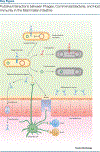Close Encounters of Three Kinds: Bacteriophages, Commensal Bacteria, and Host Immunity
- PMID: 29909042
- PMCID: PMC6436384
- DOI: 10.1016/j.tim.2018.05.009
Close Encounters of Three Kinds: Bacteriophages, Commensal Bacteria, and Host Immunity
Abstract
Recent years have witnessed an explosion of interest in the human microbiota. Although commensal bacteria have dominated research efforts to date, mounting evidence suggests that endogenous viral populations (the 'virome') play key roles in basic human physiology. The most numerous constituents of the human virome are not eukaryotic viruses but rather bacteriophages, viruses that infect bacteria. Here, we review phages' interactions with their immediate (prokaryotic) and extended (eukaryotic) hosts and with each other, with a particular emphasis on the temperate phages and prophages which dominate the human virome. We also discuss key outstanding questions in this emerging field and emphasize the urgent need for functional studies in animal models to complement previous in vitro work and current computational approaches.
Keywords: bacteriophage; lysogeny; microbiota; phageome; prophage; virome.
Copyright © 2018 Elsevier Ltd. All rights reserved.
Figures


Similar articles
-
Temperate Bacteriophages-The Powerful Indirect Modulators of Eukaryotic Cells and Immune Functions.Viruses. 2021 May 28;13(6):1013. doi: 10.3390/v13061013. Viruses. 2021. PMID: 34071422 Free PMC article. Review.
-
Virome-host interactions in intestinal health and disease.Curr Opin Virol. 2019 Aug;37:63-71. doi: 10.1016/j.coviro.2019.06.003. Epub 2019 Jul 8. Curr Opin Virol. 2019. PMID: 31295677 Review.
-
The Diverse Impacts of Phage Morons on Bacterial Fitness and Virulence.Adv Virus Res. 2019;103:1-31. doi: 10.1016/bs.aivir.2018.08.001. Epub 2018 Oct 3. Adv Virus Res. 2019. PMID: 30635074 Review.
-
Interactions between Bacteriophage, Bacteria, and the Mammalian Immune System.Viruses. 2018 Dec 25;11(1):10. doi: 10.3390/v11010010. Viruses. 2018. PMID: 30585199 Free PMC article. Review.
-
Bacteriophages of the Urinary Microbiome.J Bacteriol. 2018 Mar 12;200(7):e00738-17. doi: 10.1128/JB.00738-17. Print 2018 Apr 1. J Bacteriol. 2018. PMID: 29378882 Free PMC article.
Cited by
-
Alterations of the gut virome in patients with systemic lupus erythematosus.Front Immunol. 2023 Jan 11;13:1050895. doi: 10.3389/fimmu.2022.1050895. eCollection 2022. Front Immunol. 2023. PMID: 36713446 Free PMC article.
-
MetaHiC phage-bacteria infection network reveals active cycling phages of the healthy human gut.Elife. 2021 Feb 26;10:e60608. doi: 10.7554/eLife.60608. Elife. 2021. PMID: 33634788 Free PMC article.
-
Primate phageomes are structured by superhost phylogeny and environment.Proc Natl Acad Sci U S A. 2021 Apr 13;118(15):e2013535118. doi: 10.1073/pnas.2013535118. Proc Natl Acad Sci U S A. 2021. PMID: 33876746 Free PMC article.
-
Unprecedented Diversity of ssDNA Phages from the Family Microviridae Detected within the Gut of a Protochordate Model Organism (Ciona robusta).Viruses. 2018 Jul 31;10(8):404. doi: 10.3390/v10080404. Viruses. 2018. PMID: 30065169 Free PMC article.
-
Dynamic Modulation of the Gut Microbiota and Metabolome by Bacteriophages in a Mouse Model.Cell Host Microbe. 2019 Jun 12;25(6):803-814.e5. doi: 10.1016/j.chom.2019.05.001. Epub 2019 Jun 4. Cell Host Microbe. 2019. PMID: 31175044 Free PMC article.
References
Publication types
MeSH terms
Grants and funding
LinkOut - more resources
Full Text Sources
Other Literature Sources

